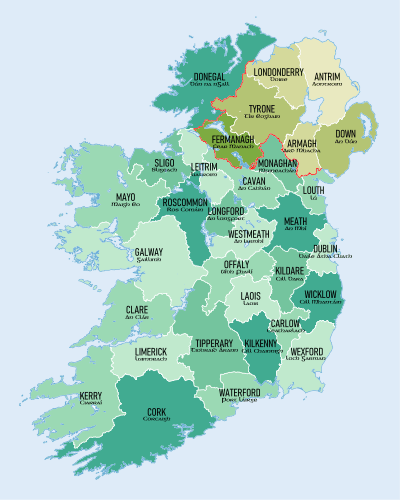County Monaghan
County Monaghan (/ˈmɒnəhən/[3]; Irish: Contae Mhuineacháin) is a county in Ireland. It is part of the Border Region and is in the province of Ulster. It is named after the town of Monaghan. Monaghan County Council is the local authority for the county. The population of the county was 61,386 according to the 2016 census.[2]
County Monaghan Contae Mhuineacháin | |
|---|---|
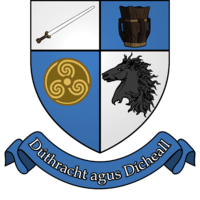 Coat of arms | |
| Nickname(s): The Drumlin County | |
| Motto(s): | |
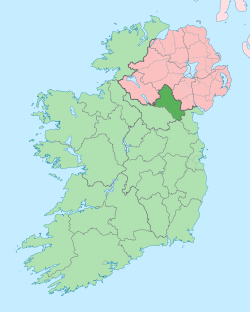 | |
| Country | Ireland |
| Province | Ulster |
| Dáil Éireann | Cavan–Monaghan |
| EU Parliament | Midlands–North-West |
| Established | 1607[1] |
| County town | Monaghan |
| Government | |
| • Type | County Council |
| Area | |
| • Total | 1,295 km2 (500 sq mi) |
| Area rank | 28th |
| Highest elevation (Slieve Beagh) | 373 m (1,224 ft) |
| Population (2016)[2] | |
| • Total | 61,386 |
| • Rank | 28th |
| • Density | 47/km2 (120/sq mi) |
| Time zone | UTC±0 (WET) |
| • Summer (DST) | UTC+1 (IST) |
| Eircode routing keys | A75, A81, H18, H23 (primarily) |
| Telephone area codes | 047 (primarily) |
| Vehicle index mark code | MN |
| Website | www |
The county has existed since 1585, when the Mac Mathghamhna rulers of Airgíalla agreed to join the Kingdom of Ireland. Following the 20th-century Irish War of Independence and the signing of the Anglo-Irish Treaty, Monaghan was one of three Ulster counties to join the Irish Free State rather than Northern Ireland.
Geography and political subdivisions
Monaghan is the fifth smallest of the Republic's 26 counties in area and fourth smallest by population.[4] It is the smallest of Ulster's nine counties in terms of population.
| Historical population | ||
|---|---|---|
| Year | Pop. | ±% |
| 1600 | 2,988 | — |
| 1610 | 4,663 | +56.1% |
| 1653 | 5,801 | +24.4% |
| 1659 | 9,734 | +67.8% |
| 1821 | 174,697 | +1694.7% |
| 1831 | 195,536 | +11.9% |
| 1841 | 200,442 | +2.5% |
| 1851 | 141,823 | −29.2% |
| 1861 | 126,482 | −10.8% |
| 1871 | 114,969 | −9.1% |
| 1881 | 102,748 | −10.6% |
| 1891 | 86,206 | −16.1% |
| 1901 | 74,611 | −13.5% |
| 1911 | 71,455 | −4.2% |
| 1926 | 65,131 | −8.9% |
| 1936 | 61,289 | −5.9% |
| 1946 | 57,215 | −6.6% |
| 1951 | 55,345 | −3.3% |
| 1956 | 52,064 | −5.9% |
| 1961 | 47,088 | −9.6% |
| 1966 | 45,732 | −2.9% |
| 1971 | 46,242 | +1.1% |
| 1979 | 50,376 | +8.9% |
| 1981 | 51,192 | +1.6% |
| 1986 | 52,379 | +2.3% |
| 1991 | 51,293 | −2.1% |
| 1996 | 51,313 | +0.0% |
| 2002 | 52,593 | +2.5% |
| 2006 | 55,997 | +6.5% |
| 2011 | 60,483 | +8.0% |
| 2016 | 61,386 | +1.5% |
| [2][5] | ||
Baronies
Civil parishes and townlands
Towns and villages
Largest Towns in County Monaghan (2016 Census)
1. Monaghan = 7,678 [6]
2. Carrickmacross = 5,032 [6]
3. Castleblayney = 3,607 [6]
4. Clones = 1,680 [6]
5. Ballybay = 1,241 [6]
Geography

Notable mountains include Slieve Beagh (on the Tyrone and Fermanagh borders), Mullyash Mountain and Coolberrin Hill (214 m, 702 ft). Lakes include Lough Avaghon, Dromore Lough, Drumlona Lough, Lough Egish, Emy Lough, Lough Fea, Inner Lough (in Dartrey Forest), Muckno Lough and White Lough. Notable rivers include the River Fane (along the Louth border), the River Glyde (along the Louth and Meath borders), the Ulster Blackwater (along the Tyrone border) and the Dromore River (along the Cavan border, linking Cootehill to Ballybay).
Monaghan has a number of forests, including Rossmore Forest and Dartrey Forest. Managed by Coillte since 1988, the majority of trees are conifers. Due to a long history of intensive farming and recent intensive forestry practices, only small pockets of native woodland remain.
The Finn Bridge is a border crossing point over the River Finn to County Fermanagh. It is close to Scotshouse.
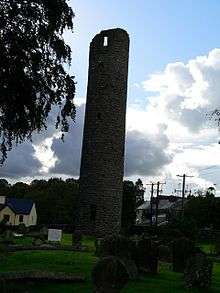
Geology
Lead was formerly mined in County Monaghan. Mines included Annaglogh Lead Mines and Lisdrumgormley Lead Mines.
History
In 1585, the English lord deputy of Ireland, Sir John Perrot, visited the area and met the Irish chieftains. They requested that Ulster be divided into counties and land in the kingdom of Airgíalla be apportioned to each of the McMahon chiefs. A commission was established to accomplish this and County Monaghan came into being. The county was subdivided into five baronies: Farney, Cremorne, Dartrey, Monaghan and Truagh, which was left under the control of the McKenna chieftains.
After the defeat of the rebellion of Hugh O'Neill, The O'Neill and the Ulster chieftains in 1603, the county was not planted like the other counties of Ulster. The lands were instead left in the hands of the native chieftains. In the Irish Rebellion of 1641 the McMahons and their allies joined the general rebellion of Irish Catholics. Following their defeat, some colonisation of the county took place with Scottish and English families.
Inland waterways
County Monaghan is traversed by the derelict Ulster Canal,[7] however Waterways Ireland are embarking on a scheme to reopen the canal from Lough Erne into Clones.
Railways
The Ulster Railway linked Monaghan with Armagh and Belfast in 1858 and with the Dundalk and Enniskillen Railway at Clones in 1863.[7]:Map 8 It became part of the Great Northern Railway in 1876.[7]:xiii The partition of Ireland in 1922 turned the boundary with County Armagh into an international frontier, after which trains were routinely delayed by customs inspections. In 1957 the Government of Northern Ireland made the GNR Board close the line between Portadown and the border, giving the GNRB no option but to withdraw passenger services between the border and Clones as well.[7]:Map 39 CIÉ took over the remaining section of line between Clones, Monaghan and Glaslough in 1958 but withdrew goods services between Monaghan and Glaslough in 1959 and between Clones and Monaghan in 1960, leaving Monaghan with no railway service.[7]:Map 39
Local government and politics
| Party | Seats | Change |
| Sinn Féin | 7 | = |
| Fine Gael | 5 | - 1 |
| Fianna Fáil | 4 | - 1 |
| Independent | 2 | = |
Monaghan is divided into four local electoral areas: Carrickmacross, Castleblayney, Clones and Monaghan.
The towns of Ballybay, Carrickmacross, Castleblayney, Clones and Monaghan are represented by nine-member town councils[8] which deal with local matters such as the provision of utilities and housing.
For the purposes of elections to Dáil Éireann, the county is part of the Cavan–Monaghan Constituency which elects five T.D.s.[9] In the 2011 general election, there was a voter turnout of 72.7%.[10]
For elections to the European Parliament, the county is part of the Midlands–North-West constituency.
Politically, the county is considered a stronghold for Sinn Féin (left wing) which is the largest party in the county, followed by Fine Gael (centre-right).
Culture and architecture
County Monaghan is the birthplace of the poet and writer Patrick Kavanagh, who based much of his work in the county. Kavanagh is one of the most significant figures in 20th-century Irish poetry. The poems "Stony Grey Soil" and "Shancoduff" refer to the county.
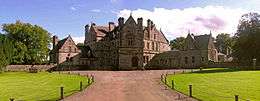
Monaghan has produced several successful artists. Chief among these is George Collie (1904–75), who was born in Carrickmacross and trained at the Dublin Metropolitan School of Art. He was a prolific exhibitor at the Royal Hibernian Academy throughout his lifetime and is represented by works in the collection of the National Gallery of Ireland and the Ulster Museum.
Monaghan was also the home county of the Irish writer Sir Shane Leslie (1885–1971), 3rd Baronet of Glaslough, who lived at Castle Leslie in the north-east corner of the county. A Catholic convert, Irish nationalist and first cousin of Winston Churchill, Prime Minister of the United Kingdom, Leslie became an important literary figure in the early 1900s. He was a close friend of many politicians and writers of the day including the American novelist F. Scott Fitzgerald (1896–1940), who dedicated his second novel, The Beautiful and Damned, to Leslie.
Monaghan County Museum is recognised as one of the leading provincial museums in Ireland, with a Council of Europe Award (1980), among others, to its credit. Located in Hill Street, Monaghan Town, the museum aims to reflect the history of Co. Monaghan and its people in all its richness and diversity.
The best of the county's architecture developed in the Georgian and Victorian periods and ranges from the dignified public spaces of Church Square and The Diamond in Monaghan Town to the great country houses of Lough Fea, Carrickmacross; Hilton Park, Clones and Castle Leslie, Glaslough.
Significant ecclesiastical buildings include St Joseph's Roman Catholic Church, Carrickmacross); the Gothic-Revival St Patrick's Church of Ireland, Monaghan town, and the St Macartan's Roman Catholic Cathedral, Monaghan town, by J. J. McCarthy (1817–1882).
Economy
Agriculture is a significant part of the County Monaghan economy, employing about 12% of the population in 2011 (compared with 5% nationally).[11] The county is the main source of egg supplies in the Republic of Ireland.[12]
Notable Monaghan people
Literature and scholarship
- Patrick Kavanagh (21 October 1904 – 30 November 1967) - Poet.[13]
- Patrick McCabe - Novelist and member of Aosdána. Born 1955.[14]
- Eugene McCabe - Playwright, novelist and screenwriter, also member of Aosdána. Born 1930, lives in Clones.[15]
- Sir Shane Leslie, 3rd Bt (1885–1971) - Writer and political activist, 3rd Baronet of Glaslough and first-cousin of Sir Winston Churchill. Resided at Castle Leslie.
- Evelyn Shirley (1812–1882) - Writer and antiquarian. Resided at Lough Fea House near Carrickmacross.
- John Robert Gregg (1867–1948) - Pioneer of modern shorthand writing.[16]
- Sir Tyrone Guthrie (1900–1971) - Writer, theatrical director and founder of the Tyrone Guthrie Centre.[17] Born in Royal Tunbridge Wells, his maternal grandmother was from Newbliss. He settled at Annaghmakerrig House in Co. Monaghan late in his life.
Politics and military
- Andrew, 11th Baron Blayney (1770–1834) - prominent military commander with the British Army, especially during the Napoleonic Wars. Also had Castleblayney, his estate town, rebuilt in the early nineteenth century.
- Sir Charles Gavan Duffy (12 April 1816 – 9 February 1903) - Irish Nationalist and Australian politician who served as Prime Minister of the Colony of Victoria. Born in Monaghan town.[18]
- Joseph Finegan- (17 November 1814 – 29 October 1885) Confederate General and victor at the Battle of Olustee
- Francis Fitzpatrick (1859–1933) - recipient of the Victoria Cross
- Eoin O'Duffy (20 October 1892 – 30 November 1944) - by turns Chief of Staff of the Irish Republican Army, Commissioner of the Garda Síochána and leader of the Blueshirts and of Fine Gael. He was also Commander of the Irish Brigade in the Spanish Civil War. Born near Castleblayney.[19]
- Juan Mackenna (1771–1814) - Military hero of the Chilean War of Independence and Co-Liberator of Chile.
- Dr Heber MacMahon, Lord Bishop of Clogher - Catholic prelate who also served as a military commander for the 'Confederation of Kilkenny' during the 1640s. He commanded at the Battle of Scarrifholis, near Letterkenny, in 1650. Bishop MacMahon was born in Inishkeen.
- Sir William Whitla (1851–1933) - Physician and politician.
- Thomas Taggart (1856–1929) - United States Senator and Mayor of Indianapolis.
- Charles Davis Lucas (1834–1914) - A native of County Armagh who was the first ever recipient of the Victoria Cross. Resided for a time at Castleshane.
- Fergal O'Hanlon (1936–1957) - IRA volunteer, killed during the Border Campaign.
- Thomas Hughes (1885–1942) - Soldier and recipient of the Victoria Cross.
- Patricia McKenna - former MEP. Born 1957.
- Dr Rory O'Hanlon - Politician, former Ceann Comhairle and former Cabinet minister. Born 1934.
- David Nelson - recipient of the Victoria Cross
- Jim Lynagh - Commander East Tyrone Brigade IRA
- Séamus McElwaine - OC South Fermanagh Brigade IRA
Sport
- Dame Mary Bailey (1890–1960) - Famous aviator who was the daughter of The 5th Baron Rossmore and wife of Sir Abe Bailey, the South African 'Randlord'.
- Barry McGuigan - World Boxing Champion 1985. Born in Clones 28 February 1960.[20]
- Tommy Bowe - Rugby Union player, born in Monaghan town, 22 February 1984.[21]
- James Cecil Parke (1881–1946) - Tennis and rugby player. Olympic silver medalist in tennis, twice winner of the Wimbledon Mixed Doubles title and Australian Men's Singles title winner. Captain of the Irish rugby team. Born in Clones.
- Kevin McBride - Olympic Boxer. Born in Clones 1973.
- John McKenna (1855–1936), the first manager of Liverpool Football Club along with W.E. Barclay.
Music and entertainment
- "Big Tom" McBride: - Country Singer. Born at Moy near Castleblayney 18 September 1936.[22]
- Oliver Callan - Satirist and mimic, born in the county in December 1980.[23]
- The Flaws - Indie Rock Band from Carrickmacross.
- Ryan Sheridan - Singer and guitarist
- Terry Cavanagh - Video game designer.
Acting
- Caitriona Balfe - Fashion model and actress, born in 1979. She currently stars in Outlander.
- Ardal O'Hanlon - Actor and comedian. Born 1965.
- Charlene McKenna - Actress. Born 1984.
- Aoibhinn McGinnity - Actress. Born 1987
Art
- Alexander Williams (1846–1930) - Artist, born in Monaghan town.
Religion
- Dr John Darley (1799–1884) - Church of Ireland Lord Bishop of Kilmore, Elphin and Ardagh, 1874–84.
- George Jeffreys (1889–1962) - Welsh founder of the Elim Pentecostal Church, which was first established in Monaghan town in 1915. The movement now has some 9,000 churches worldwide.
Twin cities
County Monaghan is twinned with the following places:
.svg.png)
.svg.png)
.svg.png)
.svg.png)
See also
- List of abbeys and priories in the Republic of Ireland (County Monaghan)
- Lord Lieutenant of Monaghan
- High Sheriff of Monaghan
Notes
- Russell, C. W. (21 June 1874). "Calendar of the State Papers, Relating to Ireland, of the Reign of James I.: Preserved in Her Majesty's Public Record Office, and Elsewhere. 1606 - 1608". Longmans, Green, Reader, & Dyer – via Google Books.
- "Census 2016 Sapmap Area: County Monaghan". Central Statistics Office (Ireland). Retrieved 25 February 2020.
- "Monaghan definition and meaning | Collins English Dictionary". www.collinsdictionary.com. Retrieved 4 January 2020.
- Corry, Eoghan (2005). The GAA Book of Lists. Hodder Headline Ireland. pp. 186–191.
- for post 1821 figures, 1653 and 1659 figures from Civil Survey Census of those years, Paper of Mr Hardinge to Royal Irish Academy 14 March 1865, For a discussion on the accuracy of pre-famine census returns see JJ Lee "On the accuracy of the Pre-famine Irish censuses Irish Population, Economy and Society edited by JM Goldstrom and LA Clarkson (1981) p54, in and also New Developments in Irish Population History, 1700–1850 by Joel Mokyr and Cormac O Grada in The Economic History Review, New Series, Vol. 37, No. 4 (Nov., 1984), pp. 473-488. Archived 9 March 2005 at the Wayback Machine
- "Percentage population change in Ireland's cities and towns, 2011-2016". Census 2016. CSO. 2016. Retrieved 21 April 2020.
- Hajducki, S. Maxwell (1974). A Railway Atlas of Ireland. Newton Abbott: David & Charles. map 9. ISBN 0-7153-5167-2.
- Archived 29 August 2010 at the Wayback Machine
- "2009 Local Election - Electoral Area details". Retrieved 27 May 2010.
- "Archived copy". Archived from the original on 7 March 2011. Retrieved 3 March 2011.CS1 maint: archived copy as title (link) - Election 2011 Cavan–Monaghan
- "Monaghan Socio Economic Profile" (PDF). Monaghan County Council. April 2015. Retrieved 8 May 2020.
- Ryan, Órla (28 April 2020). "Egg shortage in some supermarkets amid bird flu outbreak and increased demand". TheJournal.ie.
- "Life". Patrick Kavanagh 1904 – 1967. Patrick Kavanagh Trust, Trinity College Dublin. Retrieved 10 November 2009.
- "Current members. Literature: Patrick McCabe". Aosdána. Retrieved 16 October 2018.
- "Current members. Literature: Eugene McCabe". Aosdána. Retrieved 16 October 2018.
- Cowan, Leslie. "John Robert Gregg: A Biography". Oxford: The Pre-Raphaelite Press, 1984, p. 11.
- "William Tyrone Guthrie". Tyrone Guthrie Centre. Retrieved 16 October 2018.
- Joy E. Parnaby (1972). "Duffy, Sir Charles Gavan (1816 - 1903)". Australian Dictionary of Biography. Melbourne University Press. Retrieved 10 November 2009.
- "GEN. EOIN O'DUFFY (1892 -1944)". Cumann na nGaedhael History. Collins 22 Society. Archived from the original on 8 December 2009. Retrieved 10 November 2009.
- "Barry McGuigan". BoxRec.com Boxing Encyclopedia. Retrieved 10 November 2009.
- "Tommy Bowe 2009 British and Irish Lions Squad Profile". Archived from the original on 25 April 2009. Retrieved 10 November 2009.
- "Big Tom". BBC Music. BBC. Retrieved 10 November 2009.
- Chris True. "Biography: Monaghan Mimic". all music. Retrieved 10 November 2009.
External links
| Wikimedia Commons has media related to County Monaghan. |
| Wikivoyage has a travel guide for County Monaghan. |
